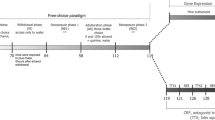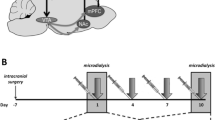Abstract
Rationale: Chronic cocaine abuse is associated with the development of anxiogenic states in humans. Corticotropin-releasing factor (CRF) is an endogenous neurotropic factor well known to modulate stress responses. It has been postulated that CRF is involved in the neurobiological mechanisms underlying the anxiety and/or stress responses associated with removal of cocaine after chronic administration. Objective: The present study investigated the role of endogenous CRF in mediating the “anxiety-like” effect 48 h after the cessation of saline or chronic cocaine treatment in rats, using the defensive burying paradigm and the elevated plus-maze. Methods: Rats received daily injections of cocaine (20 mg/kg IP, for 14 consecutive days) or vehicle. Forty-eight hours after the last injection, animals were tested in the plus-maze and then in the defensive burying paradigm. In a second experiment, intracerebroventricular (ICV) cannulae were implanted at the lateral ventricle. Animals were allowed a 1-week period for recovery before starting the chronic drug treatment. The defensive burying testing took place 48 h after cessation of the treatment. The CRF antagonist [DPhe12, Nle21,38, CαMe Leu37] r/h CRF(12–41), (also known as D-phe CRF(12–41)) (0.04, 0.2 and 1.0 μg/5 μl) was injected 5 min before the 15-min testing. Results: An “anxiogenic-like” effect following chronic cocaine treatment was demonstrated with the defensive burying paradigm, but not with the elevated plus-maze. This “anxiety-like” response was attenuated by ICV pretreatment with the CRF antagonist D-Phe CRF(12–41), with the highest dose of the CRF antagonist reversing the observed “anxiogenic-like” response. Conclusions: These data suggest that brain CRF may be substantially involved in the development of “anxiety-like” responses related to cocaine withdrawal and could be important for future drug dependence treatments.
Similar content being viewed by others
Author information
Authors and Affiliations
Additional information
Received: 11 September 1997/Final version: 4 January 1999
Rights and permissions
About this article
Cite this article
Basso, A., Spina, M., Rivier, J. et al. Corticotropin-releasing factor antagonist attenuates the “anxiogenic-like” effect in the defensive burying paradigm but not in the elevated plus-maze following chronic cocaine in rats. Psychopharmacology 145, 21–30 (1999). https://doi.org/10.1007/s002130051028
Issue Date:
DOI: https://doi.org/10.1007/s002130051028




